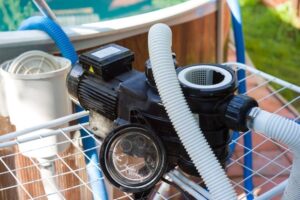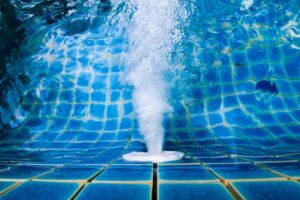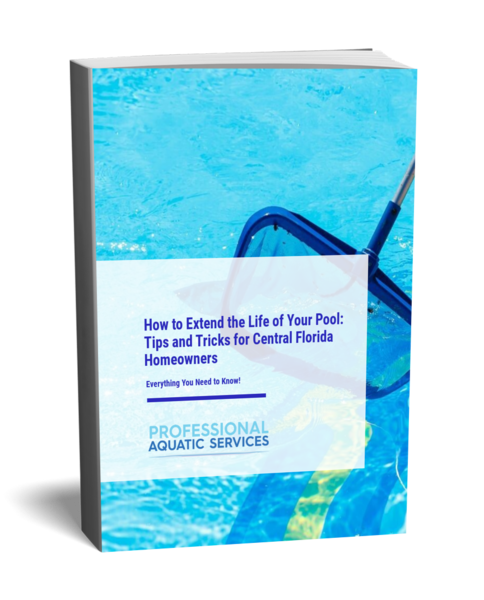Your swimming pool is a place of rest and relaxation, but when pool pump problems arise, the serenity can quickly turn into stress. The heart of your pool’s circulation system is the pool pump, a crucial piece of pool equipment designed to keep the water fresh and clear. Over time, wear and tear can have an impact on your pool pump motor, leading to issues like a clogged impeller or damaged bearings. When faced with such issues, pool pump repair is a service you might need to keep your pool in top condition.
But before rushing to call professionals, having a basic understanding of your pool pump, its components like the pump basket mechanical seal, or even knowing the difference between a standard and a variable speed pump can empower you to make informed decisions. Whether it’s identifying simple issues you can fix yourself or understanding the cost implications of repairs versus installing a new pool pump, being informed is in your best interest.
This guide provides a helpful checklist to navigate through these technical waters before seeking professional assistance for pool pump repair.
Table of Contents
ToggleUnderstanding Your Pool Pump System
A. Components and their Function
Understanding the basic components of your pool pump system is the first step toward ensuring a well-maintained swimming pool. Let’s delve into the critical parts and their functions:
- Pool Pump Motors: The electric motor is the powerhouse that drives your pool pump, enabling it to circulate water through the filtration and heating systems.
- Pump Impeller and Impeller Housing: The impeller, driven by the pool pump motor, propels water through the pump while the impeller housing encases and supports the impeller.
- Shaft and Shaft Seal: The motor shaft is a rod that extends into the pump, connecting to the impeller, while the mechanical seal prevents water from entering the motor.
- Pump Basket: This component catches debris before it reaches the impeller, preventing clogs and protecting other internal components.
- Suction and Return Lines: The suction line draws water from the pool into the pump, and the return line sends filtered and heated water back into the pool.
- O Rings and Mechanical Seal: O rings and mechanical seals ensure a tight seal between various pump components, preventing leaks and maintaining the pump’s efficiency.
B. Common Problems for Pool Pumps

Now that we have a grasp of the essential components, let’s look at common problems you might encounter which could necessitate pool water pump repair:
- Clogged Impeller or Pump Basket: Debris can obstruct the impeller or pump basket, leading to a clogged pump impeller scenario, which impedes water flow and reduces the pump’s efficiency. This common issue highlights the importance of regular cleaning to prevent such blockages and maintain your pool pump’s performance.
- Damaged Bearings or Motor Shaft: Deterioration or inadequate lubrication can lead to damaged bearings or a bent motor shaft, causing noisy operation or even a seized motor.
- Leak around the Seal Assembly: A worn or improperly seated seal can allow water to leak into the motor, posing a serious risk to your pool pump motor.
- Noisy Operation Indicating Wear and Tear: Unusual noises from your pool pump could be a red flag of internal depreciation, possibly requiring professional inspection and repair.
Knowing what each component does and recognizing common problems is crucial. This helps in performing minor fixes and communicating effectively with repair professionals when needed, ensuring that your pool remains a restful haven.
Preliminary Inspection Before Calling Repair Professionals
Before reaching out to a professional, conducting a preliminary inspection can be beneficial in two ways: it can help identify minor issues that you might be able to resolve on your own, and it can provide you with a better understanding of the status of your pool equipment. This understanding can foster effective communication with professionals, ensuring that the repair process is efficient and thorough.
A. Power and Electrical
Ensuring your pool pump is receiving power correctly is the first step in diagnosing problems.
- Ensuring Power Supply to the Pool Pump Motor: Verify that the pool pump motor is plugged in properly and the circuit breaker hasn’t tripped.
- Checking for Any Electrical Issues: Look for visible signs of electrical problems, such as burnt or frayed wiring around the pool pump or even close to it, like a pool heater. It might be wise to call a professional to avoid electrical hazards if unsure.
B. Mechanical Inspection
A mechanical inspection can uncover common wear and tear issues.
- Inspecting for Clogs in the Pump Impeller and Suction Line: Check for debris in the pump impeller and inlet line that might be hindering water flow.
- Checking the Shaft Seal and O Ring for Leaks: Examine the seal and O rings for any signs of leaks, which could lead to further damage if left unattended.
- Examining Bearings and Motor Shaft for Wear and Tear: Listen for unusual noises that might indicate worn bearings or a damaged motor shaft.
C. Hydraulic and Plumbing Inspection
The hydraulic system is crucial for maintaining the right water flow and pressure.
- Assessing Pool Pump Pressure and Vacuum: Check the pressure gauge to ensure it’s within the normal range; too high or too low pressure might indicate a problem.
- Checking Valves and Plumbing for Blockages and Leaks: Inspect the valves for blockages and the plumbing for leaks, which could affect the pool pump’s performance.
D. Cleanliness and Debris Removal:
- Cleaning the Pump Basket and Impeller Housing: Empty and clean the pump basket and clear any debris from the impeller housing to ensure smooth operation.
- Removing Debris from the Pool and Surrounding Equipment: Keep the pool and surrounding area free from debris to prevent future clogs and ensure the longevity of your pool equipment.
This preliminary inspection checklist is a proactive approach to understanding and maintaining your pool pump system. While some issues can be fixed with a little elbow grease, others might require professional assistance. Being well-informed about your pool pump’s condition can facilitate a more efficient repair process.
Considering Repair or Replacement
When facing issues with your pool pump, the dilemma often is whether to repair or replace it. This section aims to help you evaluate the best course of action.
A. Evaluating the Cost and Extent of Repairs
- Cost Comparison Between Repairing and Replacing Pool Pump Components: Compare the cost of repairing damaged parts to the price of a new pump. Sometimes, replacing certain components may be more economical in the short term, but a new pump could offer better long-term value.
- Considering the Age and Past Repair History of the Pool Pump: If your pump is older and has a history of repairs, it might be time to consider a replacement to prevent further maintenance costs.
B. Exploring New Pool Pump Options
- Benefits of Upgrading to a Variable Speed Pump: Upgrading to a variable speed pump can offer better energy efficiency, reducing operational costs and providing better control over water flow and filtration in your swimming pool.
- Energy Efficiency and Cost-saving Features of New Pump Models: Newer pump models come with enhanced energy-saving features and quieter operation. Investing in a modern pump could lower your energy bills and provide a more peaceful pool environment.
You must remember that evaluating whether to repair or replace your pool pump and considering both the immediate and long-term implications will help you make an informed decision. It can lead to better performance, reduced future repairs, and potential cost savings in maintaining your tranquil backyard oasis.
When to Call a Professional Pool Pump Repair Services
While self-maintenance is rewarding and cost-effective, certain scenarios necessitate the expertise of a pool pump repair professional to ensure the longevity and efficient operation of your swimming pool pump.
A. Determining When Professional Assistance is in Your Best Interest
It’s time to call a professional when faced with complex repairs requiring specialized tools and knowledge. Additionally, electrical and plumbing issues beyond basic troubleshooting are challenging and could be hazardous if mishandled. Some of the key factors to take into account include:
- Complex repairs requiring specialized tools and knowledge
- Electrical and plumbing issues that go beyond basic troubleshooting
B. Selecting a Pool Water Pump Repair Service
Choosing the right pool pump repair service is crucial for achieving a well-maintained pool. Evaluating the price and scope of services offered is advisable, ensuring they align with your needs and budget. Furthermore, checking the credentials and past reviews of these professionals will give you an insight into their competence and reliability. When selecting a pool pump repair service, consider the following:
- Evaluating the price and scope of services offered
- Checking the credentials and past reviews
Having a professional handle complex repairs or replacements can save you time and prevent potential mishaps. It’s about finding the right balance between what you can fix and when it’s time to call in the experts to get your pool back to its optimal running condition.
Being Well-Informed is Your Cushion Against Panic When Pool Pump Issues Arise

Having a well-maintained and fully functional pool pump is crucial for enjoying your swimming pool to the fullest. This guide has walked you through understanding the basic components of your pool pump system, conducting a preliminary inspection to identify minor issues, and the importance of evaluating whether to repair or replace your pool pump.
By following this comprehensive checklist, you become well-versed in your pool pump’s workings and better prepared to handle any issues that might arise. Whether tackling minor fixes, communicating effectively with repair professionals, or making informed decisions on repairs and replacements, being knowledgeable is your first line of defense against panic when pool pump problems occur.
Remember, a well-informed pool owner is a happy and relaxed pool owner. Your swimming pool is a source of joy and relaxation; keeping it in prime condition should never be a source of stress. Through timely action and perhaps assistance from trusted services like Professional Aquatic Services, which offers pool resurfacing projects, too, you can ensure a smooth, enjoyable pool experience.

